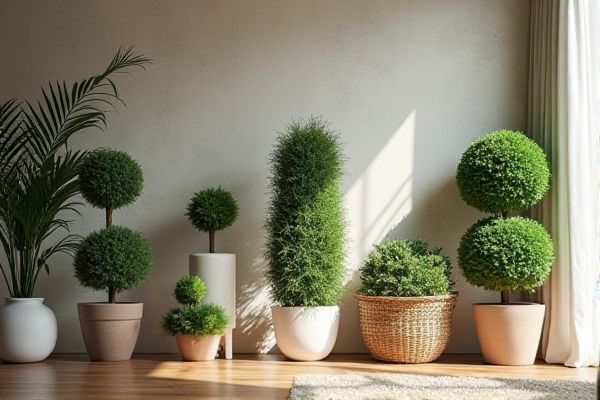
Artificial topiary offers low-maintenance greenery that retains its shape and color year-round, making it ideal for busy lifestyles or spaces lacking natural light. For those who appreciate the authenticity and growth cycle of natural plants, live topiary provides a dynamic, evolving beauty that changes with the seasons; discover which option best suits Your needs by reading the rest of the article.
Table of Comparison
| Feature | Artificial Topiary | Live Topiary |
|---|---|---|
| Maintenance | Minimal upkeep; no watering or pruning required | Regular watering, pruning, and fertilizing necessary |
| Durability | Durable, weather-resistant materials; lasts multiple years | Subject to weather, pests, and disease; longevity varies |
| Appearance | Consistently perfect shape and color | Natural growth with seasonal changes and imperfections |
| Cost | Higher upfront cost, no ongoing care expenses | Lower initial cost, ongoing care and maintenance expenses |
| Environmental Impact | Non-biodegradable materials; no carbon absorption | Supports biodiversity; absorbs CO2; improves air quality |
| Flexibility | Can be placed anywhere; no soil or climate restrictions | Requires suitable soil, climate, and space conditions |
| Customization | Pre-designed shapes; limited customization | Highly customizable through skilled pruning techniques |
Introduction to Topiary: Artificial vs Live
Artificial topiary offers a maintenance-free alternative to live topiary, featuring synthetic foliage crafted to mimic natural plant shapes and textures. Live topiary, cultivated from living shrubs like boxwood or yew, requires regular trimming and care to maintain intricate forms and promote healthy growth. Both options enhance landscape aesthetics, with artificial topiary favored for durability and low upkeep, while live topiary provides authentic greenery and seasonal variation.
Aesthetic Appeal: Comparing Visual Impact
Artificial topiary offers consistent shape and color year-round, maintaining perfect symmetry without the risk of browning or pest damage, which enhances visual appeal in controlled environments. Live topiary provides natural texture and seasonal variation, giving a dynamic and authentic aesthetic that changes with growth and weather conditions. The choice depends on preference for maintenance ease and uniformity versus natural beauty and organic charm.
Maintenance Requirements: Effort and Time
Artificial topiary requires minimal maintenance, as it does not need watering, pruning, or feeding, drastically reducing effort and time investment compared to live topiary. Live topiary demands regular care including trimming, watering, fertilizing, and pest control, which can consume several hours weekly depending on the size and complexity of the shapes. Choosing artificial topiary is ideal for low-maintenance landscaping solutions, while live topiary offers natural growth and seasonal changes but requires consistent, skilled attention.
Cost Analysis: Short-term and Long-term Expenses
Artificial topiary involves a higher initial investment due to material and manufacturing costs but requires minimal maintenance, reducing long-term expenses significantly. Live topiary has lower upfront costs but demands ongoing care such as watering, pruning, and pest control, leading to higher cumulative expenses over time. Evaluating total cost of ownership reveals artificial topiary as more economical for budget-conscious projects seeking minimal upkeep.
Environmental Impact: Sustainability Concerns
Artificial topiary often involves plastic and synthetic materials that contribute to pollution and landfill waste, raising significant sustainability concerns. Live topiary promotes biodiversity, improves air quality, and can be composted, making it a more eco-friendly choice for your garden. Choosing live plants supports environmental health, reducing your ecological footprint compared to artificial alternatives.
Durability and Longevity: Weather Resistance
Artificial topiary offers superior weather resistance compared to live topiary, maintaining its shape and color without fading, wilting, or requiring extensive maintenance. Your investment in artificial topiary ensures consistent appearance and durability through harsh weather conditions such as UV exposure, rain, and frost. Live topiary, while natural and dynamic, often suffers seasonal damage and needs ongoing care to withstand varying climates.
Customization and Design Flexibility
Artificial topiary offers unmatched customization and design flexibility, allowing for precise shapes, colors, and sizes that remain consistent year-round without maintenance. Live topiary requires skilled pruning and seasonal care, limiting design options and changing appearance with growth and weather conditions. The ability to fabricate complex forms and incorporate vibrant hues makes artificial topiary ideal for dynamic landscaping and interior decor projects.
Health and Allergy Considerations
Artificial topiary poses no risk of allergic reactions or respiratory issues, making it an ideal choice for individuals with pollen or mold allergies. Live topiary, while offering natural beauty and air-purifying benefits, can release pollen and harbor mold that may trigger allergies or worsen asthma symptoms. Your decision should consider these health factors to create a safe and comfortable environment.
Indoor and Outdoor Suitability
Artificial topiary offers exceptional durability and consistent appearance for both indoor and outdoor settings, resisting weather, pests, and low light conditions that challenge live plants. Indoor live topiary requires careful attention to light, humidity, and watering to maintain health, while outdoor live topiary thrives in natural sunlight but demands regular pruning and pest management. Choosing artificial topiary ensures low-maintenance greenery year-round, whereas live topiary enhances natural ambiance with seasonal growth and variation.
Choosing the Right Topiary for Your Space
Artificial topiary offers low maintenance and consistent appearance, making it ideal for spaces with limited sunlight or where regular upkeep is challenging. Live topiary enhances the natural aesthetic and provides air-purifying benefits but requires adequate care, pruning, and watering tailored to the plant species. Your choice depends on the environment and whether you prioritize convenience or a living, evolving garden feature.
 homyna.com
homyna.com